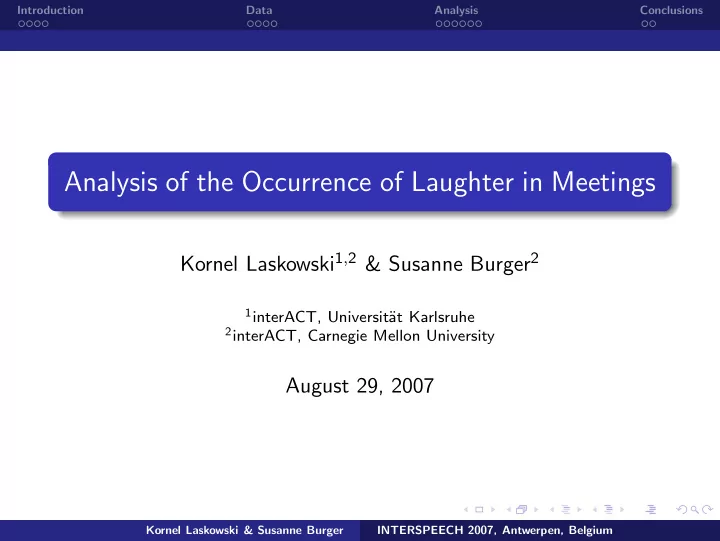

Introduction Data Analysis Conclusions Analysis of the Occurrence of Laughter in Meetings Kornel Laskowski 1 , 2 & Susanne Burger 2 1 interACT, Universit¨ at Karlsruhe 2 interACT, Carnegie Mellon University August 29, 2007 Kornel Laskowski & Susanne Burger INTERSPEECH 2007, Antwerpen, Belgium
Introduction Data Analysis Conclusions Introduction primary motivation: meeting understanding Kornel Laskowski & Susanne Burger INTERSPEECH 2007, Antwerpen, Belgium
Introduction Data Analysis Conclusions Introduction primary motivation: meeting understanding statements propositional words questions content verbal word fragments backchannel interaction disruption management floor grabbers vocalization interaction−managing both laughter emotion−relevant non−verbal other other Kornel Laskowski & Susanne Burger INTERSPEECH 2007, Antwerpen, Belgium
Introduction Data Analysis Conclusions Introduction primary motivation: meeting understanding statements propositional words questions content verbal word fragments backchannel interaction disruption management floor grabbers vocalization interaction−managing both laughter emotion−relevant non−verbal other other Kornel Laskowski & Susanne Burger INTERSPEECH 2007, Antwerpen, Belgium
Introduction Data Analysis Conclusions Introduction primary motivation: meeting understanding statements propositional words questions content verbal word fragments backchannel interaction disruption management floor grabbers vocalization interaction−managing both laughter emotion−relevant non−verbal other other Kornel Laskowski & Susanne Burger INTERSPEECH 2007, Antwerpen, Belgium
Introduction Data Analysis Conclusions Introduction primary motivation: meeting understanding statements propositional words questions content verbal word fragments backchannel interaction disruption management floor grabbers vocalization interaction−managing both laughter emotion−relevant non−verbal other other Kornel Laskowski & Susanne Burger INTERSPEECH 2007, Antwerpen, Belgium
Introduction Data Analysis Conclusions Introduction primary motivation: meeting understanding statements propositional words questions content verbal word fragments backchannel interaction disruption management floor grabbers vocalization interaction−managing both laughter emotion−relevant non−verbal other other Kornel Laskowski & Susanne Burger INTERSPEECH 2007, Antwerpen, Belgium
Introduction Data Analysis Conclusions Introduction primary motivation: meeting understanding statements propositional words questions content verbal word fragments backchannel interaction disruption management floor grabbers vocalization interaction−managing both laughter emotion−relevant non−verbal other other Kornel Laskowski & Susanne Burger INTERSPEECH 2007, Antwerpen, Belgium
Introduction Data Analysis Conclusions Introduction primary motivation: meeting understanding statements propositional words questions content verbal word fragments backchannel interaction disruption management floor grabbers vocalization interaction−managing both laughter emotion−relevant non−verbal other other Kornel Laskowski & Susanne Burger INTERSPEECH 2007, Antwerpen, Belgium
Introduction Data Analysis Conclusions Introduction primary motivation: meeting understanding statements propositional words questions content verbal word fragments backchannel interaction disruption management floor grabbers vocalization interaction−managing both laughter emotion−relevant non−verbal other other Kornel Laskowski & Susanne Burger INTERSPEECH 2007, Antwerpen, Belgium
Introduction Data Analysis Conclusions Introduction primary motivation: meeting understanding statements propositional words questions content verbal word fragments backchannel interaction disruption management floor grabbers vocalization interaction−managing both laughter emotion−relevant non−verbal other other Kornel Laskowski & Susanne Burger INTERSPEECH 2007, Antwerpen, Belgium
Introduction Data Analysis Conclusions Introduction primary motivation: meeting understanding statements propositional words questions content verbal word fragments backchannel interaction disruption management floor grabbers vocalization interaction−managing both laughter emotion−relevant non−verbal other other Kornel Laskowski & Susanne Burger INTERSPEECH 2007, Antwerpen, Belgium
Introduction Data Analysis Conclusions Introduction primary motivation: meeting understanding statements propositional words questions content verbal word fragments backchannel disruption interaction floor grabbers management vocalization interaction−managing both emotion− laughter emotion−relevant non−verbal relevant other other Kornel Laskowski & Susanne Burger INTERSPEECH 2007, Antwerpen, Belgium
Introduction Data Analysis Conclusions Introduction primary motivation: meeting understanding statements propositional words questions content verbal word fragments backchannel disruption interaction floor grabbers management vocalization interaction−managing both emotion− laughter emotion−relevant non−verbal relevant other other Kornel Laskowski & Susanne Burger INTERSPEECH 2007, Antwerpen, Belgium
Introduction Data Analysis Conclusions Introduction primary motivation: meeting understanding statements propositional words questions content verbal word fragments backchannel disruption interaction floor grabbers management vocalization interaction−managing both emotion− laughter emotion−relevant non−verbal relevant other other laughter detection is particularly important for understanding both interaction and emotion if laughter occurs frequently Kornel Laskowski & Susanne Burger INTERSPEECH 2007, Antwerpen, Belgium
Introduction Data Analysis Conclusions Introduction primary motivation: meeting understanding statements propositional words questions content verbal word fragments backchannel disruption interaction floor grabbers management vocalization interaction−managing both emotion− laughter emotion−relevant non−verbal relevant other other laughter detection is particularly important for understanding both interaction and emotion if laughter occurs frequently to date, for meetings, it is not known how much laughter there actually is 1 when it tends to occur 2 Kornel Laskowski & Susanne Burger INTERSPEECH 2007, Antwerpen, Belgium
Introduction Data Analysis Conclusions Text-Independent Modeling of Multi-Participant Meetings To find interaction, model participants jointly . Kornel Laskowski & Susanne Burger INTERSPEECH 2007, Antwerpen, Belgium
Introduction Data Analysis Conclusions Text-Independent Modeling of Multi-Participant Meetings To find interaction, model participants jointly . essentially monologue Kornel Laskowski & Susanne Burger INTERSPEECH 2007, Antwerpen, Belgium
Introduction Data Analysis Conclusions Text-Independent Modeling of Multi-Participant Meetings To find interaction, model participants jointly . “multi-logue” Kornel Laskowski & Susanne Burger INTERSPEECH 2007, Antwerpen, Belgium
Introduction Data Analysis Conclusions Text-Independent Modeling of Multi-Participant Meetings To find interaction, model participants jointly . “multi-logue” with more participant involvement Kornel Laskowski & Susanne Burger INTERSPEECH 2007, Antwerpen, Belgium
Introduction Data Analysis Conclusions Text-Independent Modeling of Multi-Participant Meetings To find interaction, model participants jointly . a mathematical artifact (the Haar wavelet basis) Kornel Laskowski & Susanne Burger INTERSPEECH 2007, Antwerpen, Belgium
Introduction Data Analysis Conclusions Text-Independent Modeling of Multi-Participant Meetings To find interaction, model participants jointly . “multi-logue” Kornel Laskowski & Susanne Burger INTERSPEECH 2007, Antwerpen, Belgium
Introduction Data Analysis Conclusions Text-Independent Modeling of Multi-Participant Meetings To find interaction, model participants jointly . “multi-logue” with laughter participants tend to wait to speak participants do not wait to laugh Kornel Laskowski & Susanne Burger INTERSPEECH 2007, Antwerpen, Belgium
Introduction Data Analysis Conclusions Three Questions of Interest 1 What is the quantity of laughter, relative to the quantity of speech? Kornel Laskowski & Susanne Burger INTERSPEECH 2007, Antwerpen, Belgium
Introduction Data Analysis Conclusions Three Questions of Interest 1 What is the quantity of laughter, relative to the quantity of speech? 2 How does the durational distribution of episodes of laughter differ from that of episodes of speech? Kornel Laskowski & Susanne Burger INTERSPEECH 2007, Antwerpen, Belgium
Recommend
More recommend